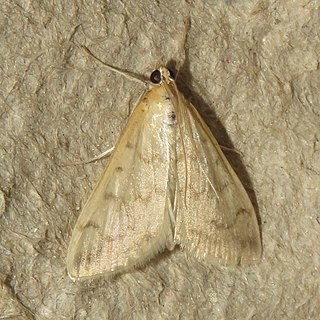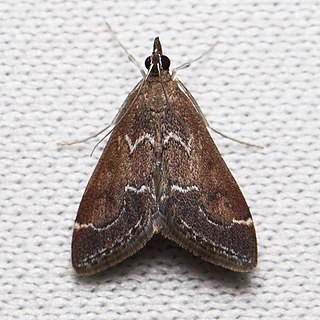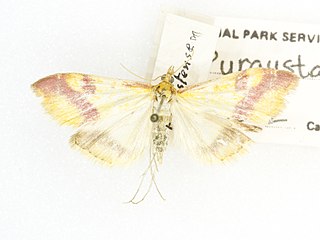
Loxostege is a genus of moths of the family Crambidae.

Spodolepis substriataria is a moth of the family Geometridae first described by George Duryea Hulst in 1896. It is found from Alaska to Nova Scotia, south in the east to New Jersey and in the west to California.

Hellula rogatalis, the cabbage webworm, is a moth of the family Crambidae described by George Duryea Hulst in 1886. It is found from the southern United States north in the east to Maryland, New York and Ontario. It is also found in Mexico, where it has been recorded from Distrito Federal.

Elophila gyralis, the waterlily borer moth, is a moth in the family Crambidae. It was described by George Duryea Hulst in 1886. It is found in eastern North America, where it has been recorded from Alabama, Florida, Georgia, Illinois, Indiana, Iowa, Louisiana, Maine, Maryland, Massachusetts, Michigan, Minnesota, Mississippi, New Brunswick, New Hampshire, New Jersey, New York, North Carolina, Nova Scotia, Ohio, Oklahoma, Ontario, Pennsylvania, Quebec, South Carolina, Tennessee, Texas and Wisconsin.
Crambus trichusalis is a moth in the family Crambidae. It was described by George Duryea Hulst in 1886. It is found in North America, where it has been recorded from Alberta, Saskatchewan, Montana, North Dakota and South Dakota. The habitat consists of grasslands.
Abegesta reluctalis is a moth in the family Crambidae. It was described by George Duryea Hulst in 1886. It is found in North America, where it has been recorded from Arizona, California, Maryland and New Mexico.

Hahncappsia pergilvalis is a moth in the family Crambidae. It was described by George Duryea Hulst in 1886. It is found in North America, where it has been recorded from Ontario and the north-eastern and south-western United States. It is also present in Mexico, where it has been recorded from the Federal District, Puebla and Jalisco.

Loxostege allectalis is a moth in the family Crambidae. It was described by Augustus Radcliffe Grote in 1877. It is found in the United States, where it has been recorded from southern California to Texas. To the south, the range extends into Mexico and Central America.
Loxostege anartalis is a moth in the family Crambidae. It was described by Augustus Radcliffe Grote in 1878. It is found in North America, where it has been recorded from coast to coast in Canada. In the west, the range extends south to California.

Loxostege lepidalis is a moth in the family Crambidae. It was described by George Duryea Hulst in 1886. It is found in North America, where it has been recorded from Alberta and eastern Washington to California and New Mexico.
Loxostege kearfottalis is a moth in the family Crambidae. It was described by E. V. Walter in 1928. It is found in North America, where it has been recorded from California to western Texas and in Colorado.
Loxostege oberthuralis is a moth in the family Crambidae. It was described by Charles H. Fernald in 1894. It is found in North America, where it has been recorded from southern California, southern Arizona and southern Nevada.
Loxostege offumalis is a moth in the family Crambidae. It was described by George Duryea Hulst in 1886. It is found in North America, where it has been recorded from California.

Pyrausta napaealis is a moth in the family Crambidae. It was described by George Duryea Hulst in 1886. It is found in the United States, where it has been recorded from Washington to California and west to Arizona, Nevada, New Mexico and Texas. It is also found in northern Mexico.

Pyrausta nexalis, the fulvous-edged pyrausta moth, is a moth in the family Crambidae. It was described by George Duryea Hulst in 1886. It is found in North America, where it has been recorded from Washington, Montana, Arizona, California, New Mexico, Oklahoma, Texas and Utah.

Pyrausta scurralis is a moth in the family Crambidae. It was first observed and described by George Duryea Hulst in 1886. It is found in North America, where it has been recorded/reported in the Canadian provinces of Ontario, Manitoba and Saskatchewan to the US states, California, Arizona, and New Mexico and in Mexico.
Sitochroa aureolalis is a moth in the family Crambidae. It was described by George Duryea Hulst in 1886. It is found in the United States, where it has been recorded from southern California to Arizona and Texas. It is also found in northern Mexico.

Chloropteryx tepperaria, the angle-winged emerald moth, is a moth of the family Geometridae. The species was first described by George Duryea Hulst in 1886 and it is found in the southeastern United States.
Noctueliopsis bububattalis is a moth in the family Crambidae. It was described by George Duryea Hulst in 1886. It is found in North America, where it has been recorded from Arizona, California, Colorado, New Mexico, Texas and Utah.
Pero radiosaria is a species of moth in the family Geometridae. It was described by George Duryea Hulst in 1886 and is found in North America, where it has been recorded from southern California to Texas.










